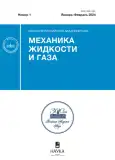Диагностика ионизационных процессов в углеводородном пламени с использованием вольтамперных характеристик
- Авторы: Полянский В.А.1, Панкратьева И.Л.1
-
Учреждения:
- Московский государственный университет им. М.В. Ломоносова
- Выпуск: № 1 (2024)
- Страницы: 77-82
- Раздел: Статьи
- URL: https://gynecology.orscience.ru/1024-7084/article/view/672131
- DOI: https://doi.org/10.31857/S1024708424010049
- EDN: https://elibrary.ru/sduwdg
- ID: 672131
Цитировать
Полный текст
Аннотация
Рассматривается возможность оценки ионизационных параметров высокотемпературных газовых смесей, образующихся в результате процессов горения, на основе вольтамперных характеристик, измеренных с помощью электродов, создающих в исследуемых средах внешнее электрическое поле.
Полный текст
Об авторах
В. А. Полянский
Московский государственный университет им. М.В. Ломоносова
Автор, ответственный за переписку.
Email: ilpan@imec.msu.ru
Научно-исследовательский институт механики
Россия, МоскваИ. Л. Панкратьева
Московский государственный университет им. М.В. Ломоносова
Email: ilpan@imec.msu.ru
Научно-исследовательский институт механики
Россия, МоскваСписок литературы
- Karnani S, Dunn-Rankin D. Detailed characterization of DC electric field effects on small non-premixed flames // Combust. Flame. 2015. V. 162(7). P. 2865–2872.
- Gan Y.H., Wang M., Luo Y.L., Chen X.W., Xu J.L. Effects of direct-current electric fields on flame shape and combustion characteristics of ethanol in small scale // Adv. Mech. Eng. 2016. V. 8(1). P. 1–14.
- Власов П.А., Панкратьева И.Л., Полянский В.А. Исследование ЭГД-структуры течения высокотемпературной газовой смеси с неоднородным источником заряженных частиц // Изв. РАН. МЖГ. 2022. № 6. С. 94–100.
- Власов П.А., Панкратьева И.Л., Полянский В.А. Исследование механизмов взаимодействия углеводородного пламени с электрическим полем // Изв. РАН. МЖГ. 2023. № 4. С. 108–116.
- Pankratieva I.L., Polyanskii V.A. Modeling electrohydrodynamic flows in slightly conducting liquids // J. Applied Mechanics and Technical Physics. 1995. V. 36. № 4. P. 513–519.
Дополнительные файлы
Доп. файлы
Действие
1.
JATS XML
2.
Рис. 1. Вольтамперные характеристики для трех различных конфигураций факела по ширине и интенсивности (высоты ступеньки) источника ионизации W. Линии: 1 — W = 10, 0.2 < x < 0.8; 2 — W = 5, 0.2 < x < 0.8; 3 — W = 10, 0.4 < x < 0.6; 4 — W = 6, 0.4 < x < 0.6; 5 — W = 4, 0.4 < x < 0.6; 6 – W = 10, 0.47 < x < 0.53; 7 – W = 4, 0.47 < x < 0.53.
Скачать (86KB)
3.
Рис. 2. Зависимость тока насыщения от интенсивности источника заряженных частиц W для разной ширины горящей области L. Линии: 1 — L = 0.06, 2 — L = 0.2, 3 — L = 0.6, 4 — L = 1.
Скачать (73KB)
4.
Рис. 3. Зависимость тока насыщения Jsat от характерного размера источника заряженных частиц L для разных W. Линии: 1 – W = 2, 2 – W = 4, 3 – W = 6, 4 – W = 8, 5 – W = 10.
Скачать (85KB)
5.
Рис. 4. Зависимость тока насыщения Jsat от произведения LW (линия 1); линия 2 – величина А в соотношении (2.1) для разных значений LW.
Скачать (60KB)
6.
Рис. 5. Электроды полностью погружены в область горения. Распределения концентраций заряженных частиц и объемного заряда q в слабом приложенном поле (W = 4, L = 1, Fw = –100). Линии: 1 — n1, 2 — n2, 3 — q.
Скачать (68KB)
7.
Рис. 6. Электроды полностью погружены в область горения. Распределения электрического потенциала F (линия 1) и напряженности поля E (линия 2) в слабом приложенном поле (W = 4, L = 1, Fw = –100).
Скачать (61KB)
8.
Рис. 7. Вольтамперные характеристики электродов, полностью погруженных в область ионизации (W = 4, L = 1).
Скачать (55KB)















